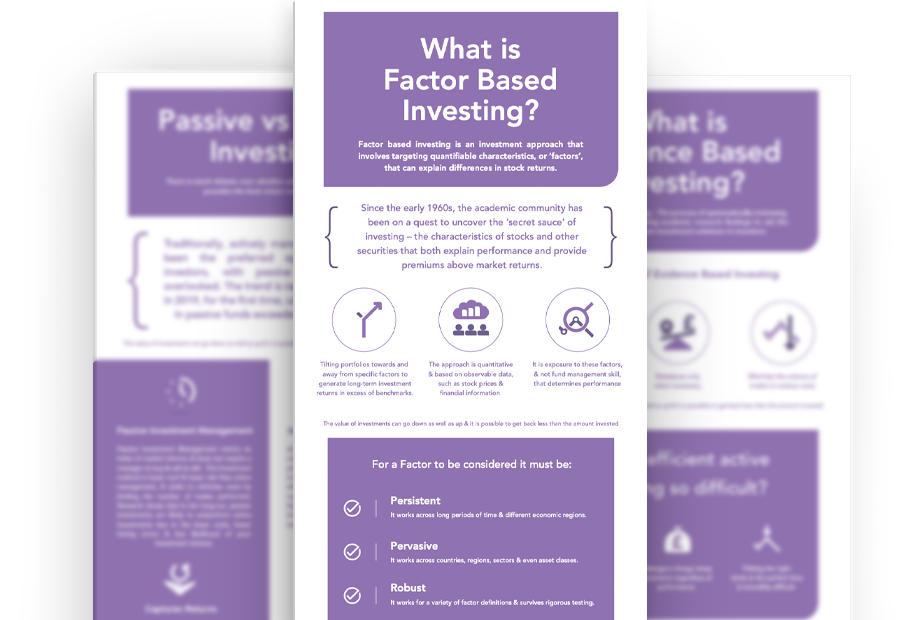Factor Based Investing
Factor based investing is an investment approach that involves targeting quantifiable characteristics,
or ‘factors’, that can explain differences in stock returns.

Factor based investing is an investment approach that involves targeting quantifiable characteristics, or ‘factors’, that can explain differences in stock returns.
Since the early 1960s, the academic community has been on a quest to uncover the ‘secret sauce’ of investing – the characteristics of stocks and other securities that both explain performance and provide premiums above market returns.
Factors are simply a set of properties common to a broad set of securities. Contrary to popular belief, it is the exposure to these factors, and not fund management skill, that determines performance.

Download our Factor Based Investing infographic
An easy to understand infographic detailing the core principles of factor based investing.
Why use factor based investing?
Potentially generate above market returns
May improve diversification
Manage portfolio risk
Jargon Buster

What is factor tilting?
A factor based investment strategy involves tilting portfolios towards and away from specific factors to generate long-term investment returns in excess of benchmarks. The approach is quantitative and based on observable data, such as stock prices and financial information, rather than on opinion or speculation.
To learn more about ebi’s factor based investing approach, contact our team.
Factors in ebi’s portfolios
More than 600 factors have been identified so far, but only a handful meet all of the criteria above. ebi’s evidence based investing approach identifies five key factors which it uses within its Vantage Earth portfolios.
Different factors provide relative outperformance vs the market at different points in time, and at different points in the economic cycle. While the evidence suggests that it isn’t possible to identify economic cycles and resulting factor performance in advance, it should be noted that historically there have been a number of factors that have typically outperformed in recessionary environments.
Minimum Volatility

Stocks which exhibit lower volatility have returns above that which would be implied by the efficient market theory.
Momentum

The tendency of stocks that have performed well, continuing to perform strongly into the future, at least for a short time.
Quality

Profitable firms generate higher returns than unprofitable firms, despite having significantly higher valuation ratios.
Value

Stocks priced closer to their book value, have higher expected returns than stocks priced far above their book value.
Size

Companies with a lower market capitalisation, exhibit a returns premium over companies with a large market capitalisation.
Column 1
Q4 2023 Factors Review
In our Q4 video Jonathan Griffiths examines the long-term relative factor returns over time periods to 31.01.2023
For a factor to be considered it must be:
Helping our advisers succeed
“I have been working with ebi for around 5 years and had some great support over that period. Their proposition has evolved alongside our own investment philosophy. Their ability to work really well with some of the best advisory platforms is a real benefit to us. I have recommended their investment services to my peers and will continue to do so.”
Richard, Bristol



